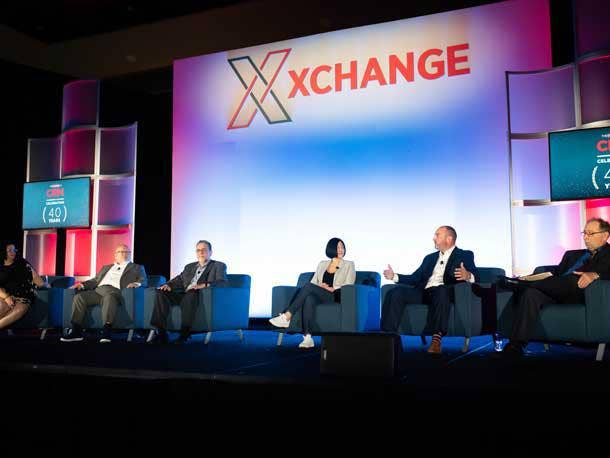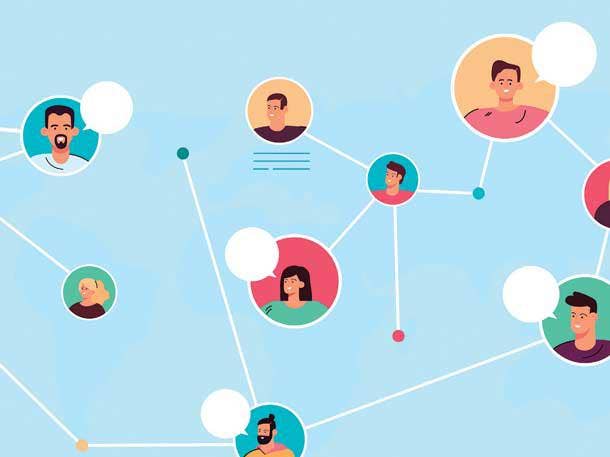CRN 40th Anniversary Panel: 5 Key Ways The Channel Has Evolved
CRN has been a ‘catalyst’ in bringing alignment to the channel and bridging the gap between the vendor and the solution provider, says Jason Wright, CEO of MSP Avatar Computer Solutions, in a panel discussion with other executives at XChange 2022.

While technology and ways to do business have changed tremendously over the past 40 years, one thing that has remained steadfast has been servicing customers and solving their issues.
In a panel to celebrate CRN’s 40th anniversary, executives spoke about how the channel has evolved over time and what partners, distributors and vendors must do to keep growing. The panel was hosted at CRN parent company The Channel Company’s XChange event in Denver this week.
The panel was moderated by Jennifer Follett, vice president of U.S. content and executive editor of CRN, and Steve Burke, news editor at CRN. Panelists included Blaine Raddon, CEO of The Channel Company; Jason Wright, CEO of Houston-based MSP Avatar Computer Solutions; Michael Goldstein, president of Fort Lauderdale, Fla.-based MSP LAN Infotech; and Donna Grothjan, vice president of worldwide channels at Aruba, a Hewlett Packard Enterprise Company.
The panel members began by reflecting on how they started in the industry and how CRN played a pivotal role in helping them keep up with current industry news.
When Goldstein first found CRN, he knew he was its key audience.
“I was like, ‘Oh my God, they’re talking to me,’” he said.
For Grothjan, CRN was the way to keep up with what was going on in the market and find insight into how to look at her business and enhance it. It also provided a pulse on how her company was doing in relation to competitors and if it was staying up to date.
“It’s a bible,” she said. “It made me really start to question myself, am I doing the right things in my role or company and what’s top of mind with solution providers?”
Wright said CRN has been a “catalyst” in bringing alignment to the channel and bridging the gap between the vendor and the solution provider.
“It’s really about service, delivery and execution,” he said, adding that people do business with individuals they like.
“This hasn’t changed,” he said. “So 99.99 percent of the relationships I have were garnered at these conferences. CRN and The Channel Company have done a swimmingly good job of building community.”
Derek Nwamadi, co-founder and CEO of Dallas-based MSP Quantum Symphony, said the panel was a good look at where the channel needs to go to remain viable.
It’s about being a trusted adviser, becoming more focused on value selling and doubling down on business outcomes, he said.
“It’s not just about the technology and the future trends, that’s very important, but how do you as an MSP be able to say, ‘This is the business outcome of why we’re doing what we’re doing?’” he said. “If you hold us accountable to the business outcomes, the technology pieces that we integrate become that much more valuable because they can tie it together.”
Here are five ways the channel has changed over 40 years and what needs to be done to be successful in the future.

The Channel Has Gone From Vendor-Focused To Customer-Focused
Raddon said the channel in the 1980s was an extension of the vendor. Today, the channel is all about the customer.
“It’s all about what customers we serve, what industries we serve, so that evolution has been a really, really important change in the business,” Raddon said.
Grothjan said it was “a lot easier” back then. “Things were a lot more linear.”
The biggest change she has seen is that customers can be vendors and vendors can be customers.
“I think the world is changing in that software truly is a partner ecosystem,” she said.
Wright has seen the shift from a capital expense model to a consumption model as IT budgets have moved away from IT and into the line-of-business sectors.
And it’s been fewer cataclysmic shifts and more incremental changes over the years to boost revenue streams.
“Oftentimes you hear people say, ‘You’ve got to listen to the customer, you’ve got to listen to the customer,’” he said. “Sometimes I don’t know if we polled our customers well enough and that’s one thing we’ve assessed is where we’re at with our clients.”
It’s all about listening to the customer needs. If you on-board them and there’s an on-boarding problem, you lost that customer relationship, he said.
For Goldstein, it used to be all about the numbers and how much MSPs can sell. Today, it’s more of a relationship.
“We really want to make sure that we do serve the customer’s purpose,” he said.

Business Model Shifts Accelerating
Grothjan said “here and now” is when the biggest business model shifts are happening.
“In today’s world customers are really looking for that single trusted adviser,” she said. “We’re really working closely with partners to understand how they’re managing customer life cycles today as opposed to project-based sales. It’s all about customer life-cycle management.”
She said it’s important as a vendor to acknowledge the services partners provide and how they can support those services.
“It’s really about the customer mindset,” she said.
Goldstein said his company is “making more money than ever before.”
“It’s all about service and helping the client understand,” he said. “The good and the bad is it’s complex. They do need us.”
Raddon said it’s all about the evolution of the channel. For him, the role distributors play in the evolution is key. Distributors invested heavily in the cloud when the iron was hot and worked directly with vendors to deliver their offerings, he said.
“We still can’t really say what distribution will look like five years from now,” he said. “But if they don’t change, they don’t survive.”

Cultural Traits To Be Successful In The Fast-Paced Channel
Wright said his company is nothing without its staff. He’s evolved his MSP to offer “big company benefits” including flexible scheduling and unlimited time off.
“When we talk about culture, we just went through the greatest pandemic, the greatest black swan event in 100 years this world has seen,” he said. “We kept the world going. We are the corporate first-responders. We are the ones they call when things hit the fan.”
Grothjan said one way to harness a great culture is to listen to millennials in how they see the world as she’s noticed a shift of the mindset. She added that that generation is also focused on corporate responsibility and sustainability.
She shared when a millennial was once asked what advice they’d give to their mother. It was to stop saying, “That’s the way we’ve always done it.”
“Look at what’s happening now from a pandemic perspective, nothing is normal,” she said. “Things are different. You have to be flexible. You have to be agile. If you’re dealt this hand of cards, you have to just make the best hand out of it.”
Raddon said the younger generations want to work for a company that has a heart.
“To me, the culture is the community,” he said.
Goldstein noticed a cohesive effort from companies in the channel during the pandemic to help customers go remote.
“We couldn’t convert manufacturing into making hand sanitizer or vaccines, so we turned around and actually worked with Microsoft and provided a lot of Teams training,” he said.
When schools went remote, his company helped about 600 local teachers learn how to use the Teams messaging platform.

Vendor Approaches To The Channel Have Changed
Grothjan said vendors have always looked at the channel community as an extension of themselves.
“It’s completely shifted,” she said. “Customers ultimately are looking to buy as a service. They need somebody who is going to drive business outcomes for them.”
She said while vendors provide the technical aspect, it’s the partner who is the trusted adviser. In turn, vendors must look at the entire channel ecosystem and provide more specialized applications. The partner brand has to be the vendor’s brand, she said.
“It’s like, ‘What do we do to help you in this particular vertical?’” she said, adding that vendors have to look at solutions from the partner point of view as a customer.
Goldstein wants to be “the best I can be with my key vendors.”
“I want everyone to know in their team who we are, that’s where referrals come out,” he said. “If they don’t know about you, how are they going to find you, especially if you’re a small MSP?”
There aren’t many vendors who don’t see the value of the channel, Raddon said. He said five to seven years ago, many vendors dismissed the channel.
“That’s becoming farther and farther away,” he said.

How Business Models Must Change To Grow In The Future
For Wright, it’s continued progression toward “the ascension to that summit.”
“When you look at the cybersecurity landscape, if you look at the evolving threat vectors … and now cyber insurance is coming into them … [customers] don’t realize the exposure they open themselves up to,” he said. “They don’t know this and it’s our job to educate and inform them.”
It’s also about working with customers through every aspect of their business such as employee engagement and talent retention.
Grothjan said the business model is driven by data.
“It’s one thing to create data and store it, but now it’s all about analyzing data and leveraging it and driving business outcomes based on it,” she said. “And then to sell services based on the ability to drive those business outcomes.”
Raddon said it’s not about speeds and feeds. It’s a partnership, he said, and the customer has to be an extension of an MSP’s organization.
Goldstein is focusing on the customer experience.
“Service delivery is everything,” he said. “We want to be that trusted source. It’s really just analyzing a little deeper … and making sure their experience is the best experience.”